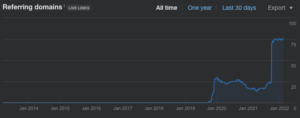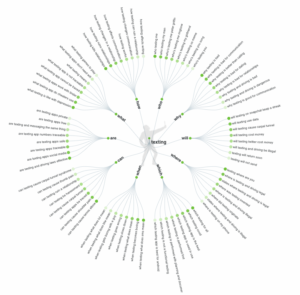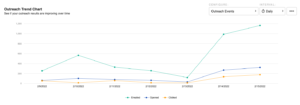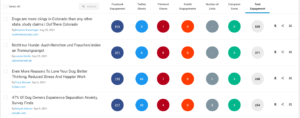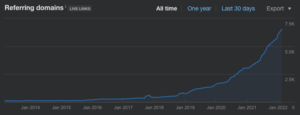Table of Contents
Digital PR is a term that refers to using public relations strategies to improve digital presence. At Go Fish Digital, our digital PR agency builds backlinks from media outlets. These backlinks from authoritative and credible sites act as a vote of confidence and ultimately aid overall SEO efforts.
But how do you secure these backlinks? The secret weapon to link building is tangential content, or in other words, an interesting article, report, or study designed to produce newsworthy insights.
Related Content:
In this guide, I’ll walk through the process we use to build high-quality backlinks and explain why it works.
What Is Digital PR?
Digital PR is a marketing technique that utilizes content, social media, SEO and influencer marketing to earn coverage from media outlets. The goal of digital PR is to help a brand earn more online exposure, impressions, and backlinks.
Digital PR is similar to traditional PR in that it relies on relationship-building strategies in order to secure earned media. Both involve a form of outreach targeted at reporters, editors, publishers, or other media contacts.
They also both revolve around mutually beneficial relationships, meaning that the media outlet benefits from the information received while the client benefits from the exposure.
While the two strategies share similar tactics, they differ in their goals and KPIs. A traditional PR campaign may aim to increase event attendance, drive product sales, or encourage participation.
A digital PR campaign on the other hand may focus on strengthening the health of a website, increasing search engine visibility, or driving new users to your site. Both traditional and digital PR share the goal of increasing brand awareness.
Because of these unique objectives, a digital PR campaign will look very different from a traditional one. Digital PR campaigns are often less related to the company’s brand, products, and service offerings by comparison, as they focus on overall digital presence rather than a specific marketing initiative.
The Ideation Phase
Before you can consider reaching out to journalists, you have to come up with something to share with them. No matter how great you are at outreach, a pitch can only be as good as the content you’ve created—that’s what makes this first step of your digital PR strategy so critical.
Everyone has their own way of getting their creative juices flowing. There’s truly no right or wrong way of brainstorming, but there are a few helpful things to keep in mind.
First and foremost, keep the end goal top of mind. Ultimately, the purpose is to build backlinks, not to promote your brand or service. You can (and should) ideate around topics that relate to your industry but keep the content’s reach as broad as possible.
For example, SimpleTexting, an SMS marketing company, could produce content around texting or advertising. But to expand the potential outreach pool, we did “An Analytical Deep Dive into The Office”, something a broad audience can relate to, but with a tie back to the office environment and drawing parallels among TV scripts and marketing.
This campaign secured over 80 backlinks, including ones from Mental Floss and Cheat Sheet.
Ultimately, the more creative freedom you give yourself during the brainstorm, the easier the next steps of the process will be.
Finding Inspiration
When starting a brainstorm, you should be as open-minded as possible. At this stage in the process, there is no such thing as a bad idea. Avoid shooting down concepts because you don’t know how you’ll find the data or because you think it might not be interesting. You’ll iron out all those details later on in the process.
If you have a team, it can be extremely helpful to involve others in ideation. Even if it’s just someone to bounce ideas off of, talking out a potential digital PR campaign concept can often surface other inspired ideas and things you wouldn’t have thought of on your own.
Buzzworthy and trending topics are also great places to start. If you can add to an already popular conversation with a new piece of research, you’ll have an easier time landing coverage than you would if you had to convince a journalist why your research is interesting.
For example, if a particular TV series or movie was trending in the news, you could run an analysis of it to provide extra data to a journalist who may already be writing a piece about it.
Social media platforms are a good source for insight into what is currently trending and upcoming. Simply scrolling through Instagram, Twitter, Facebook, and TikTok can often spark ideas.
To go deeper, Reddit may also be used as inspiration through following subreddits related to your client’s industry and even larger communities like r/AskReddit or r/TodayILearned that engage thousands of users daily.
Not only can posts inspire ideas, but comments can also lead to a potential campaign. If you’re interested in learning more about using Reddit for content ideation, my colleague Daniel Russell spoke at MozCon on this very topic.
When you have a specific topic, AnswerThePublic.com can be a useful resource. It’s a search listening tool that shows the most popular Google searches around a specific keyword.
It can be used to broaden a particular topic from one keyword to dozens of related questions and concepts. You may find that a question people commonly ask about a given phrase could turn into a whole campaign in itself.
One of the best sources of inspiration can also be your competitors. Keeping up with the campaigns that others are using in the digital PR world can be incredibly helpful to get ideas of your own rolling.
You may be able to draw from not only a topic you see someone else doing, but you could also replicate formats or data sources where applicable, so long as your content is still unique and original.
Turning Ideas Into Campaign Concepts
Once you have a solid list of ideas, you should go through and vet for the best. This is the time to be critical and separate the ideas that are truly unique and interesting from the ones that fall flat.
Think about not only what you believe to be interesting, but also what appeals to the widest audience. It helps to have another set of eyes to offer a fresh perspective. At Go Fish, campaigns go through four people minimum before we pitch them to a client.
If you’re having trouble deciding what’s interesting enough to make the cut, envision what the final campaign would look like and put yourself in a reporter’s shoes. Consider the following questions:
- What headlines could result from this campaign?
- If you got a pitch about it in your inbox, would you cover it?
- Would the data make sense to the average person?
- Is there any way you can tie the campaign back to something that’s going on in the news now?
During this phase, we also run a few different content checks. Confirming feasibility is extremely important—there’s nothing worse than having an idea selected, only to find out that there’s no way to realistically gather the data weeks into the process.
The more preparation you do in this stage, the easier it will be to actually produce the campaign. Nail down what sources you’ll be using, how you’ll collect the information, and if it’s a survey, maybe even draft a few sample questions. You should have a fairly clear vision for the direction of the campaign.
Finally, hunt around to see what’s already out there on the topic. If an idea has already been done before, you’ll have a tougher time landing coverage. Odds are that an outlet won’t want to cover the same thing twice.
As a rule of thumb, we usually avoid redoing a campaign if it’s been done within the past two years because the data would likely be substantially similar. It’s best to select ideas where the topic is relevant enough to spark interest but offers an additional insight or new angle to set it apart from the competition.
If you run into issues with uniqueness, brainstorm ways you could differentiate the topic from what’s already out there or simply table the idea for the time being.
A simple Google search suffices here, but be thorough with it. Think of all of the different angles and ways the story could be presented so that you’re aware of what potential competition exists.
After you’ve thoroughly researched each idea, you may realize that your list of dozens of ideas has turned into only a handful of viable potential campaigns. That is completely normal and one of the reasons you should try to get as much out of the initial brainstorm as possible.
Keep in mind that it’s better to select from a small batch of campaigns that you’re fully confident in than a large set that could be hit or miss.
The Production Phase
Once you’ve nailed down a topic to run with, it’s time to bring your idea to life! This will be highly dependent on the idea selected, but at Go Fish Digital, we usually do some form of research, blog copy, and graphic development.
Some of the most popular campaign formats include data analysis, surveys, and interactive pieces.
Data Analysis
Data analyses rely on existing datasets to tell a new story or provide additional insight. For example, we mapped out the best cities for cats based on the number of veterinarians from the Bureau of Labor Statistics, the number of adoptions from Shelters Animals Count data, and more.
You can also use tools to pull or scrape a given data point. That includes things such as Google Trends for measuring search volume and popularity by location or Yelp for identifying frequency or ratings of a given category. Less common tools can be used for more niche methodologies, such as Hashtagify for scraping social media hashtags, for example.
With data campaigns, there’s often the opportunity to analyze by a number of factors, including location as seen in the above example. Doing this not only allows you to crunch the numbers from a different angle, but it also substantially expands your outreach pool. It localizes the story so you could then pitch the findings to relevant reporters in each city or state, in addition to the national outlets.
One key thing to keep in mind when it comes to data is that it’s important to provide an extra level of analysis. Be careful to avoid simply regurgitating the findings, as a media outlet could do that on its own. Whether it’s breaking down the data by various demographics or combining multiple sources to draw bigger conclusions, be sure that your campaign will be adding something to the conversation.
Surveys
In many cases, there may not be an existing dataset to match your idea, which is where surveys come into play. There are a variety of platforms (Pollfish, MTurk, and Prolific are a few we’ve used) that host surveys and collect responses.
Once you have your data, you can analyze it by demographics such as gender, generation, and more to find the most interesting insights.
Surveys have few limitations beyond your imagination. You can create a campaign around any topic and draw from nearly any pool of respondents.
Depending on the survey platform you’re using and your desired sample size, you can screen for a certain subset of the population. You can survey a certain demographic (like people that make above a certain income), behavior (people that go to the gym regularly), interest (people that love a certain movie genre), or other factors.
The questions you write will make or break your survey. When you’re drafting the questions, think about the potential insights each question will produce. Try to find the less obvious questions that will in turn help expand your topic’s reach.
For example, if you were running a survey on work-life balance, you could add in a series of questions about how dating affects your career. That would allow you to pitch your insights to not only career and business reporters but also those that cover topics on dating and relationships.
Multiple choice questions are great, but push yourself to incorporate creative question formats like would you rather, rankings, and open-ended questions. You can use media (like photos or videos) when necessary to add to your survey.
In the above survey, we asked Americans what lengths they would go to keep their smartphones. We asked a series of would you rather questions pitting everyday luxuries against each other: would you rather give up your smartphone or your pet? Your significant other? Your morning coffee?
It’s important to note that a survey’s authority lies heavily in the sample size. For U.S. national surveys, samples should be no smaller than 1,000 respondents, but the bigger the better. The cost and time it takes to gather responses are two of the biggest cons to this format. Account for these when you’re ideating campaigns initially to avoid any surprises.
Interactive Content
A final campaign format we often use is interactive content. This could be in the form of a quiz, tool, or contest—anything that an audience can directly engage with. A great example is this calculator that reveals how quickly tech CEOs can make your salary.
Interactive content performs well because people love to read about things they can relate to and engage with. In addition, a journalist wants to write stories that will resonate with their audience, so the more engagement your content can generate, the more likely a reporter is to cover it.
This type of campaign typically requires some development work, so be sure that both your team and your website is capable of supporting whatever concept you come up with.
Creative Assets
Once the research is compiled, put it together in a way that’s digestible and makes sense to the average person. Graphics are a great way to get a lot of information across in a way that’s easy to understand.
Utilize creative data visualization techniques beyond traditional charts, such as relevant imagery and color schemes, to make your content pop. Pay careful attention to the labels and keys you include, as these are instrumental in conveying the meaning of the data.
Copy can be used to bring everything together and fill in any missing gaps. When you’re writing the blog, put yourself in the reporter’s shoes—what would you want to know if you were trying to decide whether or not to cover it? Methodology details (What sources did you use and why? How did you conduct the research? When did you do the analysis?) are helpful to include along with a relatable hook in the introduction.
The blog is also an opportunity to highlight any of the statistics that you felt were interesting but didn’t make the graphics.
The Promotion Phase
Once all of the assets of the campaign are ready to launch, you can begin promoting the content. Ideally, you’ll have the promotional materials ready to go when the campaign is live. The sooner you can start outreach for your digital PR campaign, the fresher and more enticing the content will be to your audience.
Building a Media List
Building a media list starts with identifying the target media outlets that are most likely to cover the campaign. From there, you can further narrow down the outreach pool by finding relevant contacts at those outlets. Reporters, editors, and producers within beats that match your campaign are great people to start with.
Media databases like Cision and Pressrush are helpful for identifying and narrowing down a list of targets. There’s a fine line between quality and quantity. A larger volume of contacts gives you more people to pitch and thus more outreach potential.
However, that only matters if the contacts are relevant to the subject you’re pitching. Someone that covers crime and politics will never pick up your story about dogs, no matter how solid your pitch is. Do your research on the types of content each reporter covers rather than blindly adding them to your list.
Keep your media list organized in a way that makes sense to you. Our team uses a spreadsheet that can easily be updated throughout the promotional period with any pertinent notes. This is also helpful to refer back to if you’re pitching multiple campaigns with similar topics—you can always pitch people again in the future.
Unique Outreach Angles
Think outside of the box when you’re building your media list. For example, a campaign about pet separation anxiety would obviously be a great fit for reporters that cover pet content. But by focusing on how pets are affecting their owner’s desire to work from home versus returning to the office, you could open up outreach to career and business reporters.
That’s how we were able to secure backlinks from Forbes, People, and the Animal Rescue Site, all in one campaign. Coming up with unique outreach angles like this one will give you more people to pitch and more opportunities for backlinks.
Don’t be afraid to include people you’ve never talked to on your media list. Though it certainly helps to have a pre-existing relationship with a journalist, it’s a major misconception that this is a requirement for outreach. Cold pitching can be successful when done correctly.
Drafting a Pitch
Perfecting promotion strategies requires not only finding the right people but also pitching with the right message. Journalists’ inboxes are constantly flooded with story ideas so presenting your content in a way that stands out is critical.
Grab journalists’ attention with a catchy, newsworthy subject line. Keep it light by getting to the point and quickly highlighting your most interesting findings.
Since the subject line directly impacts a pitch’s opportunity for success, you should come up with a few different options. You might test out one that summarizes the campaign, one that highlights a key stat, and one that’s phrased in the form of a question. From there, you can A/B test each subject line with a small sample of contacts from your media list in order to gauge which has the most potential.
Here are some examples of what a subject line could look like:
- Report investigates what lengths Americans would go to for their phone
- 40% of Americans would give up their dog over their smartphone [survey data]
- What would you sacrifice to keep your smartphones? Survey finds out…
There’s no magic formula for a pitch, do it however works best for you and your content. Many of our outreach messages are two to three sentences for an introduction and overview, three to five bullets of insights, and two to three closing sentences with any key methodology notes.
Your outreach message is not just a presentation of your findings. Instead, think of it as a chance to convince the recipient that it’s something worth talking about.
One way to do this is to tie the content back to something that’s already going on in the news. Nearly anything can be connected to a current event.
For example, in the above “best cities to be a cat” campaign, though the content is evergreen and not related to any specific event, mentioning the fact that cat adoptions have surged amidst the COVID-19 pandemic adds a little more relevancy.
Similarly, for the “tech CEOs calculator,” pitching around and referencing the antitrust investigation of 2020 where Zuckerburg, Bezos, and others testified, made a major difference in outreach.
The more you can personalize your outreach, the better. If you can mention a reporter’s hometown or a recent story they’ve written, that increases your chances of resonating with them. Include statistics relevant to the person you’re pitching—so if you’re pitching someone in North Carolina, tell them what you found out about their state’s residents.
Following Up
You may also choose to include a follow-up approximately three to five days after your initial pitch. This gives the recipient a second chance to consider your content. It also provides you another opportunity to sell the campaign. Be careful not to pester with your follow-up—one additional email usually suffices.
Remember that public relations is all about building mutually beneficial relationships, so make your case for how your content will help the person you’re pitching and their audience.
Conducting Outreach
The pitching period will look different for each campaign that you run. Generally, we try to pitch our content for a minimum of six weeks. That allows for plenty of time to test out strategies, figure out what’s working, and hone in on your most successful angles.
If you have the resources to invest in an email software like Buzzstream or Yesware, it will substantially help your outreach. Not only can it speed up the time you spend in your inbox, but it can also provide helpful insight into who’s opening and clicking your emails. These stats will help fine-tune your pitch to find the perfect message that resonates the most.
For a benchmark, we typically consider an open rate above 35% and/or a click rate above 10% to be a solid pitch. These stats aren’t perfect as many email servers block tracking software.
If your pitch is not getting any traction, you may have been flagged for spam. This happens if your email account gains a bad reputation or if your pitch triggers a spam filter. Avoid using phrases like “free info,” “risk-free,” or “guaranteed.”
Don’t worry if you don’t receive much feedback right away. This doesn’t mean your link building campaign failed! Reporters will often cover a story without even responding to you—that means you’ve provided them with all the information they needed upfront.
Keep an eye out for unlinked mentions where a reporter covers your campaign but does not include a link back to your site. You can find these by setting up a Google news alert to keep track of times your topic or website is mentioned. In these cases, you should reach back out and request appropriate attribution.
Around the three to four week mark, if you still haven’t received coverage, try to come up with ways you can revamp what you already have. Maybe that means looking for a new angle of people to pitch to, reworking your outreach message, or even going back to the production phases and adding additional data.
It can also be helpful to have another set of eyes look through your campaign. By this point, you’ve spent a lot of time looking at the campaign. Bringing in a colleague to offer a new perspective and help you identify the most interesting pieces of your campaign can go a long way.
Measuring Success
Once you’ve kicked off outreach you can finally sit back and watch the links come in. Tools like Ahrefs and Buzzsumo are great for monitoring backlinks. It also helps to monitor content manually via social media and search engines.
You may want to keep track of factors such as domain authority, anchor text, and whether a link is follow or nofollow and canonical or syndicated as these each impact a link’s value differently.
Our team also analyzes link prominence (How much of the story is focused on the campaign—is it the focal point of the story or simply an added source?) and link relevance (How relevant is the media outlet to the client’s industry?).
Other metrics that may be important are landing page sessions, social shares, and estimated coverage views. While backlinks are likely the primary goal of digital PR campaigns, there are many additional benefits worth reporting on that can help you further refine your digital PR strategy down the line.
Case Study
Like many SEO efforts, link building is a long-term strategy. You likely won’t see results overnight, but with persistence, it can make a big difference in your site’s visibility.
SimpleTexting launched their first digital PR campaign in August of 2016. Since then, they’ve produced over 30 campaigns earning nearly 1,000 organic links in sum.
Their campaigns have covered a wide range of topics over the years, some more closely related to the brand than others. Some have tapped into the marketing side of their business, such as a report on restaurant loyalty during the pandemic and a survey on how mobile shopping affects spending habits.
Others have focused more on the consumer side with a tie-back to phones such as the dating app survey and the analysis of screen time usage by state.
They’ve also utilized a variety of campaign formats, from the surveys and data analyses mentioned above to a contest where people were invited to apply to binge-watch movies for the chance to win $1,000.
Wrapping Up
One of the benefits of digital PR is that these campaigns easily build on themselves. With enough traction, they’ll continue to passively build links over time. That means that you may see coverage continue to roll in, years after you stop pitching it.
Not every campaign will be a home run, so don’t give up if you don’t earn the traction you hoped for at first. Keep trying new campaign formats, topics, and outreach strategies until you find what works.
Digital PR is also most impactful when supplemented with additional SEO strategies, so continue implementing optimizations and updates for best results.
Search News Straight To Your Inbox
*Required
Join thousands of marketers to get the best search news in under 5 minutes. Get resources, tips and more with The Splash newsletter:

